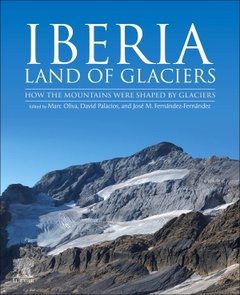Iberia, Land of Glaciers How The Mountains Were Shaped By Glaciers
Coordonnateurs : Oliva Marc, Palacios David, Fernández-Fernández José M.

Iberian glaciation has resulted in ice expansion through valleys that are now used by the road network and where important populations settle; in addition, large accumulations of sediments deposited by those glaciers are still unstable today and can trigger risks for mountain populations. Iberia, Land of Glaciers presents the impact of the glaciers in the landscape of mountains following a more educational perspective with examples of 21 Iberian massifs written by specialists from each of the areas.
2. Quaternary ice ages in the Iberian Peninsula
3. The Glacial Landscapes of the Iberian Peninsula within the Mediterranean region
4. The Iberian Peninsula: From paleoglaciers to the current glaciers
5. Iberia: Land of the ancient glaciers
Marc Oliva holds a PhD in Geography from the Universitat de Barcelona, where he works now as research scientist and leads a research group on Antarctic, Arctic and Alpine Environments. He has carried out research and teaching activities in universities of Portugal, Canada, Switzerland, Spain and Russia. He has participated in tens of expeditions to Antarctica and the High Arctic. Apart from the Polar Regions, he has also conducted research in other mountain regions (Rocky Mountains, Alps, N Iceland, Pamir, Tien Shan, Pyrenees, and Cantabrian Mountains), which has provided him a wide comprehension of Earth surface processes in cold-climate environments. His research interests include the study of geomorphological processes and past environments and climate in the Polar Regions and high mountains using a wide range of natural records (glacial, periglacial, and lacustrine).
David Palacios is Full Professor of Physical Geography at the Complutense University of Madrid, Spain. He has been the coordinator for Spanish National Projects since 1998 to the present, and Spanish coordinator of two European Projects. He has served as founder and director of the High Mountain Physical Geography excellence research group for 12 years, and has authored over 200 international research papers, 100 chapters, and has edited five books.
José M. Fernández-Fernández holds a PhD in Geography from the Universidad Complutense de Madrid (Spain), where he is Assistant Professor. His research has focused on the relationships between glaciers and climate at different timescales since the last glacial cycle and the use of nunataks as key proxies of palaeoenvironmental evolution. He has conducted research in several mountains of Iceland (Tröllaskagi Peninsula), the Iberian Peninsula, and Antarctica (South Shetland Islands).
- Assesses present-day Iberian Peninsula landscape trends by understanding the past behavior of glaciers
- Includes the latest findings of all the major Iberian mountains in a single book
- Includes quality, color figures to enhance understanding of glacier formations
- Provides a more educational and pedagogical perspective on glacial processes to reach an audience beyond academia
Date de parution : 09-2021
Ouvrage de 618 p.
19x23.4 cm
Thème d’Iberia, Land of Glaciers :
Mots-clés :
Atlantic climate; Atlantic glacier; Cantabrian Mountain; Cantabrian Mountains; Central Range; Central-Eastern Pyrenees; Central-Western Asturian Mountains; Central-Western Pyrenees; Cirque glaciers; Cirque; Climate change; Cosmogenic nuclides; Debris-covered glaciers; Deglaciation; Fuentes Carrionas; Galicia; Geopark; Glacial asynchrony; Glacial chronology update; Glacial evolution; Glacial geomorphology; Glacial landforms; Glacial landscape; Glaciation; Glaciations; Glaciers; Glaciokarst; Global change; High mountains; Holocene; Iberian Northwest; Iberian Peninsula; Iberian Range; Ice extent; Ice fields; Interglacials; Lake Sanabria; Last glacial cycle; Last Glacial Cycle; Late Glacial; Late pleistocene; Late Quaternary; León province; Little Ice Age; Low-altitude glaciers; Marginal glaciers; Mediterranean; MIS6Moraine; Montaña Palentina; Montes de León; Paleoceanography; Paleoclimatology; Paleoglaciers; Paraglacial; Periglacial; Picos de Europa; Plateau glacier; Plateau ice field; Pleistocene; Pyrenees; Quaternary; Radiocarbon dating; Redes Natural Park; Rock glaciers; Sierra de Gredos; Sierra Nevada; Sierras de Guadarrama y Somosierra; Southeastern Pyrenees; Terminal trays; Topography; Vizcodillo; Wide-bottom hollow



